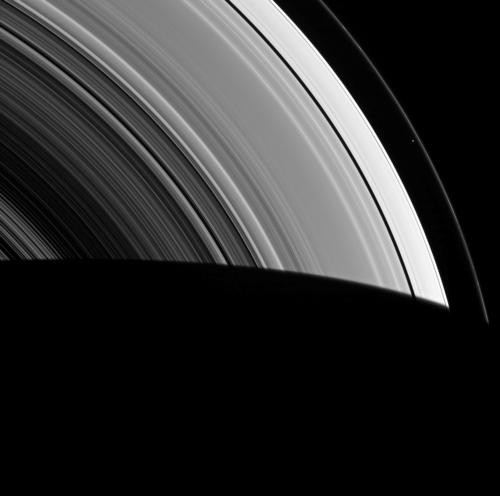Saturn's F Ring Gives Birth To and Destroys Its Own Moonlets in a Never-ending Cycle
| Ana Verayo | | Sep 11, 2014 12:08 PM EDT |
(Photo : NASA/JPL-Caltech/Space Science Institute) The small dot located in Saturn's outer F-ring is Prometheus, a moonlet the size of a mountain.
While orbiting Saturn, the Cassini spacecraft observed that moonlets are constantly being born and destroyed to die and form again around the F ring surrounding the Ringed planet.
A pair of observations were made three decades apart by SETI Institute astronomers and the oldest of these was recorded by the Voyager spacecraft which was launched in the 1970's. Significant differences between the two recordings took place over a remarkable short period of time at least in astronomical terms and could be explained further by the creation and destruction of tiny moons found in the ring.
Like Us on Facebook
According to Robert French of the SETI Institute, the F ring is made out of pure of water ice and is known to have bright spots but its appearance has fundamentally changed since the time Voyager recorded its changes. There are now fewer of those very bright lumps where those bright spots have the ability to appear and disappear over the course of a few days in the F ring.
Moonlets which are roughly the size of mountains, which form and then collide with other particles in the most dense part of the F ring and astronomers think that this is an effect that causes these bright spots to be inconsistent.
Edouard Roche who was a 19th Century French astronomer, first proposed the idea that a moon orbiting closer within a certain distance near its parent planet would be eventually torn apart by gravitational forces. Known as the Roche limit, it is the critical distance between a moon and the larger world.
Since Saturn's F ring is located in the outskirts of the main ring system, it is within the Roche distance from the giant planet. The gravitational forces here can cause rocks to converge and form into a larger body that could measure up to a few miles in diameter.
Since there are millions of bodies orbiting in such close proximity to each other, these collisions are quite common and can ultimately tear these bodies apart.
Discovered by the Voyager 1 spacecraft in 1980, Prometheus is orbiting just inside the F-ring. This 60-mile diameter moon aligns with the ring where gravity attracts the creation of large numbers of moonlets.
Upon studying Cassini data, further research will determine if Prometheus encourages a large number of tiny bodies to ignite the creation of moonlets the size of mountains.
TagsSaturn's F Ring Gives Birth To and Destroys Its Own Moonlets in a Never-ending Cycle, mini moons in saturn's f ring, moonlets saturn f ring, moons appear and disappear in saturn, saturn moons, prometheus, Saturn, saturn rings, roche limit, cassini, NASA, prometheus moonlet, moonlets
©2015 Chinatopix All rights reserved. Do not reproduce without permission
EDITOR'S PICKS
-

Did the Trump administration just announce plans for a trade war with ‘hostile’ China and Russia?
-

US Senate passes Taiwan travel bill slammed by China
-

As Yan Sihong’s family grieves, here are other Chinese students who went missing abroad. Some have never been found
-

Beijing blasts Western critics who ‘smear China’ with the term sharp power
-

China Envoy Seeks to Defuse Tensions With U.S. as a Trade War Brews
-

Singapore's Deputy PM Provides Bitcoin Vote of Confidence Amid China's Blanket Bans
-

China warns investors over risks in overseas virtual currency trading
-

Chinese government most trustworthy: survey
-

Kashima Antlers On Course For Back-To-Back Titles
MOST POPULAR
LATEST NEWS
Zhou Yongkang: China's Former Security Chief Sentenced to Life in Prison

China's former Chief of the Ministry of Public Security, Zhou Yongkang, has been given a life sentence after he was found guilty of abusing his office, bribery and deliberately ... Full Article
TRENDING STORY

China Pork Prices Expected to Stabilize As The Supplies Recover

Elephone P9000 Smartphone is now on Sale on Amazon India

There's a Big Chance Cliffhangers Won't Still Be Resolved When Grey's Anatomy Season 13 Returns

Supreme Court Ruled on Samsung vs Apple Dispute for Patent Infringement

Microsoft Surface Pro 5 Rumors and Release Date: What is the Latest?










